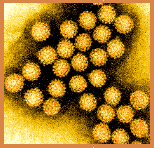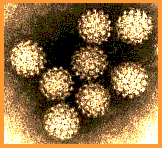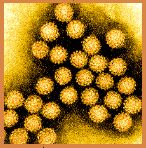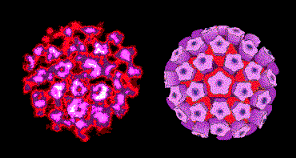Many types of papillomavirus cause benign skin tumours (warts) in their natural hosts. These warts often regress spontaneously, but human genital warts (tumours caused by specific types of papillomavirus, particularly types 16 and 18) regularly become malignant if they persist for a sufficiently long time.
Papillomavirus particles are approximately 55nm in diameter.
The capsid is composed of 72 morphological units, or capsomers, arranged on the surface of a T=7 icosahedron. The capsomers located at each of the 12 vertices, are pentavalent (i.e. each is surrounded by five adjacent capsomers), and the other 60 capsomers are hexavalent (each adjacent to six capsomers).
A model of the papillomavirus capsid is shown beside a computer colorized EM image.
All 72 capsomeres are pentamers of the major structural protein, termed L1. This arrangement of subunits violates the theory of quasi-equivalence put forward by Caspar and Klug in 1962. (See Principles of Virus Architecture)
© Copyright Dr Linda M Stannard, 1995
This page was written by Dr Linda Stannard, on behalf of the Division of Medical Virology, UCT.
In Memory of Dr Linda Stannard, 10 May 1942 - 17 October 2016
For re-use of and queries about Dr Stannard's images, please contact Dr Stephen Korsman at stephen.korsman@uct.ac.za.
Recipient of Key Resource Award





